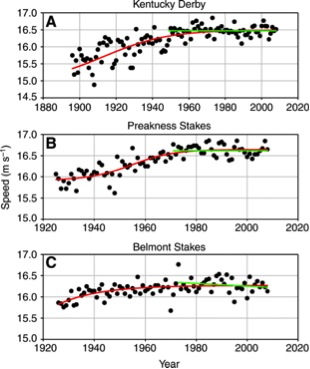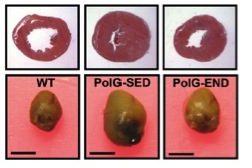Archive for June, 2013
Secretariat and Non-Human Limits!
The Belmont Stakes horse race will be run this Saturday. Forty years ago Secretariat won the 1.5 mile race by an incredible 31 lengths. His time of 2:24 is faster by 2 seconds than the next fastest time posted over the last 40 years. Some have argued that Secretariat’s run at the Belmont in 1973 is the greatest performance in sports history. The video below shows this remarkable feat.
click here for video
Last summer during the Olympics I posted a number of videos of people like Bob Hayes and Jim Ryun and also wrote about the role of relaxation and rhythm in sports. Note the length of the great horse’s stride and how little Secretariat’s head bobs. From what I can tell his jockey never uses the whip. Have you ever seen such power and relaxation at the same time?
Humans Still Getting Faster
One other piece of brain candy related to this is that as a result of selective breeding over several hundred years horses may have reached a plateau in terms of performance. The figure below is from a fascinating 2008 paper that shows this for the three Triple Crown races.
By contrast, the data from humans suggest that we are still getting faster, at least in some events. The human to animal comparison is confused by major changes in training, technique, equipment, and (unfortunately) doping for humans. There are also more humans competing at a high level than ever before as the population grows and more people from more countries participate. Things in horse racing have been relatively stagnant by comparison. As I mentioned last summer when reasonable assumptions about artificial tracks are made it is unclear if performances are physiologically better now than in the 1960s.
Summary
Thinking about records and the limits of performance is an interesting intellectual exercise that can shed light on all sorts of things and fuel a lot of fun arguments. Watching a performance like Secretariat’s always leaves me with a sense of awe. I hope you enjoy it as much as I do.
Exercise vs. Aging
Almost all of the data I show in this blog comes from studies in humans or various population databases. I am going to make an exception today and show you some data about what happens when mice that are genetically modified to age early are also subjected to exercise training.
Mitochondrial Aging the Key?
One idea is that a prime driver of the aging process is a loss of mitochondrial function over time. The mitochondria are small energy factories in our cells. When they become defective the idea is that byproducts released from the mitochondria damage cells and cause aging. The picture below shows what happens when the system responsible for DNA proof reading in the mitochondria is absent in mice. The animal on left is a control while the animal on the right is aging prematurely due to the genetic alteration. The mice are called progeroid because they have features associated with a rare form of premature aging that is seen in humans called progeria.
Exercise Keep Mitochondria Healthy
Exercise keeps our mitochondria healthy as we age and it also stimulates muscle and other tissues to increase the number of mitochondria in each cell. So what happens when porgeroid mice exercise trained for 45 minutes per day three times per week for five months? The pictures below show the hearts of the mice. The panels on the left are from wild type (WT) that is genetically normal. The middle panels show an enlarged heart from porgeroid animal that was sedentary. The right panel shows that exercise training blunted the response seen in the sedentary animal.
The authors concluded that:
“Here we show that 5 months of endurance exercise induced systemic mitochondrial biogenesis, prevented mitochondrial DNA depletion and mutations, increased mitochondrial oxidative capacity and respiratory chain assembly, restored mitochondrial morphology, and blunted pathological levels of apoptosis in multiple tissues of mitochondrial DNA mutator mice. These adaptations conferred complete phenotypic protection, reduced multisystem pathology, and prevented premature mortality in these mice. The systemic mitochondrial rejuvenation through endurance exercise promises to be an effective therapeutic approach to mitigating mitochondrial dysfunction in aging and related comorbidities.”
These data and the conclusions drawn from this study clearly confirm and explain what is happening in the master athlete super agers we have discussed before.
You are currently browsing the Human Limits blog archives for June, 2013.






